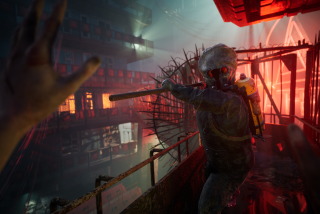Console Battle Keeps Game Makers From Scoring Big
- Share via
As the computer gaming industry converges on Los Angeles for its annual trade fair, two Southern California game makers reported red ink Tuesday, caught by consumers’ wait for the next generation of game consoles to be released.
Santa Monica-based Activision, publisher of the popular “Tony Hawk’s Pro Skater” video game, said Tuesday that it lost nearly $53 million in its fiscal fourth quarter ended March 31. That includes a charge of $70 million for a company restructuring. Revenue for the quarter fell 10% from the year-ago quarter to $103.4 million.
Without the charge, Activision would have earned $1 million compared with a $5-million profit in the same period a year earlier.
Meanwhile, Interplay Entertainment Corp. in Irvine said it lost $5.5 million in the first quarter ended March 31, down from a $8.3-million loss in the same period a year earlier. Revenue in the quarter fell 16% to $18.1 million.
Though both companies have popular game titles headed for store shelves, they are caught by consumer confusion over which rival video game console to buy, and that has hurt the share price of most major game makers this year.
Activision’s shares have fallen 53% this year, closing down 22 cents at $7.28 in Nasdaq trading Tuesday. Interplay shares are off 13% this year and closed unchanged at $2.56 on Nasdaq.
Other big losers include Electronic Arts, based in Redwood City, Calif., whose shares are down 31% this year. Midway Games in Chicago, is down 68%; THQ Inc, based in Calabasas, is down 35%; and 3DO in Redwood City, is off 38%.
To bolster its stock price, Activision said Tuesday it will repurchase up to $10 million of its shares.
When the executives of these companies join the 50,000 visitors expected to attend the Electronic Entertainment Expo, or E3, convention, which runs Thursday through Saturday at the Los Angeles Convention Center, they will be looking to Sony Corp. to sort out the mess in the video game market.
The industry wants to hear Sony’s plans for its PlayStation 2 video game console, including details about the price of the machine, when it will go on sale this year and how many consoles it can build. Analysts say that information will help consumers start to make buying decisions. The machine is already on sale in Japan.
Game makers in the $5.4-billion industry in the United States are caught in a transition from earlier game machines such as Nintendo’s N64 and Sony’s first PlayStation, to flashier models that will enable owners to play games, watch DVD movies and access the Internet.
Adding to the confusion is Sega’s Dreamcast model, which sold 225,000 units in the first quarter, according to PC Data. The machine is seen as transitional between the older consoles on the market and the newer designs expected to be introduced over the next 18 months.
“Once Sony announces the official date of PlayStation 2’s release, consumers will start to make decisions,” said Bill Chardavoyne, Activision’s chief financial officer. “Either [consumers] will buy N64 or PlayStation 1 now, or decide to wait for the new console and games.”
Nintendo is working on its own state-of-the art console, called Dolphin, due out in 2001. And Microsoft is entering the field with its X-Box game player scheduled for next year.
The current hesitation in the market by consumers is illustrated by the falling prices for games.
Retail prices for console games are 10% below last year, according to Chardavoyne. A year ago, only 9% of PlayStation games sold for under $20, whereas today that’s the price point for nearly a third of them, he said. Moreover, the industry’s top titles are selling fewer numbers compared with last year.
3DO cited that confusion in the marketplace last month when it warned that its earnings would fall below Wall Street’s expectations.
On Tuesday, 3DO said revenue for its fourth quarter ended March 31 doubled to $47.3 million, helped by the introduction new titles, while earnings rose to $11.5 million from $2.6 million a year ago. Still, that earnings jump was significantly below earlier estimates.
“We have been talking about convergence for a decade with nothing to show for it. Now, the first two so-called convergence boxes--PlayStation 2 and Microsoft’s X-Box-will come out this year and next,” said James Lin, an analyst with ING Barings in Los Angeles.
(BEGIN TEXT OF INFOBOX / INFOGRAPHIC)
They’ve Got Game
Sega’s Dreamcast has captured market share from other players since its debut last year. Many consumers are waiting for new machines from Sony, Nintendo and Microsoft before replacing older models.
(BEGIN TEXT OF INFOBOX / INFOGRAPHIC)
The New Contenders
Microsoft X-box
Expected release: 2001
Price: Analysts estimate about $300
Illustrating the convergence of PC and console technology, the X-box will use an Intel Pentium III processor, Nvidia 3D graphics processor, 64Mb of memory, an 8Gb hard drive, a DVD drive and Internet connectivity.
*
Nintendo Dolphin
Expected release: First half of 2001, initially planned for this year.
Price: not available
Dolphin will run on a 400-MHz “Gekko” IBM processor, ArtX graphics chip and will include a Matsushita/Panasonic DVD drive.
*
Sega Dreamcast
Debuted September 1999
Price: $199
The 128-bit machine produces fast, realistic graphics; a 56K-modem enables players to access the Internet and participate in multiplayer games; the central processor is a 200Mz Hitachi SH-4, which rivals some Pentium processors.
*
Sony Playstation II
Expected release: Fall 2000
Suggested retail Price: About $300
Playstation 2 will run on a 128-bit “Emotion Engine” CPU, with DVD drive that can play DVD movies and CD audio as well as original Playstation games; built-in ports willenable users to add peripherals.
*
Sources: Company websites, CNET
*
Researched by NONA YATES / Los Angeles Times







